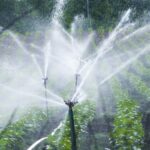Smart sprinkler systems are revolutionizing lawn care, but what happens when programming errors and zone control issues disrupt your irrigation plans? Inconsistent watering can lead to patchy lawns and wasted resources, making it crucial to tackle these glitches swiftly. Understanding and resolving these common problems will help you maintain an efficient and healthy irrigation system.
- Uncover the common programming and zone control errors that could be affecting your smart sprinkler system’s performance.
- Learn proven methods to identify and rectify programming glitches, ensuring that your watering schedules run seamlessly.
- Explore targeted strategies to resolve zone control problems, from valve malfunctions to connectivity issues, for optimal lawn coverage.
With this comprehensive guide, you’ll gain the insights necessary to troubleshoot your smart sprinkler controller, helping you achieve a lush and evenly watered lawn. Delve into the specifics and discover how these solutions can enhance your irrigation strategy.
Understanding Common Smart Sprinkler Controller Errors in Programming and Zone Control
Smart sprinkler controllers are designed to automate lawn irrigation, but they are not without their challenges. Two prevalent issues often encountered are programming faults and zone control failures.
Programming errors typically arise from incorrect scheduling inputs or software bugs, resulting in inefficient watering schedules that can overwater or underwater different areas. These missteps not only waste water but also threaten the health of your lawn by promoting either drought stress or root rot.
Zone control problems occur when specific zones fail to activate or deactivate as intended. This can be caused by connectivity issues with your smart controller or malfunctioning valves. Such problems lead to inconsistent watering, where some areas of your lawn receive too much water, while others get too little.
Addressing these smart sprinkler controller errors is essential to maintaining a healthy and lush landscape. Early identification and resolution can significantly enhance the efficiency of your irrigation system.
Troubleshooting Programming Errors: Solutions for Smart Sprinkler Controller Glitches
When dealing with programming errors, it is crucial to first double-check the schedules you have set. Ensure that the timings align with your lawn’s needs and seasonal changes.
Advanced solutions might involve updating the firmware of your smart sprinkler controller. Manufacturers often release firmware updates to fix bugs and improve functionality. Regularly checking for and installing these updates can prevent many glitches.
If issues persist, consider resetting the controller to its factory settings. This step can resolve many unknown software issues, allowing you to start fresh with a new configuration.
Finally, consistent monitoring of your controller’s performance will aid in identifying programming glitches early, facilitating timely interventions to maintain a smooth and effective irrigation system.
Effective Strategies to Resolve Smart Sprinkler Controller Zone Control Problems
Zone control problems in smart sprinkler systems are not only common but can significantly affect the efficiency of lawn irrigation. Whether you’re dealing with valve malfunctions or connectivity issues, resolving these problems promptly is crucial to maintaining an effective irrigation system.
Valve Malfunctions: A primary source of zone control issues lies within malfunctioning valves. If the sprinkler zones are not activating as per schedule, start by checking the valves. Ensure there is no physical blockage or damage to the valve. Examine the valve’s solenoid by listening for a clicking sound when switching zones. If there’s no sound, it might be time for a replacement.
Another strategy is to check for debris build-up in the solenoid port. Clean any obstructions with care to restore proper functionality. Remember, a clean valve is a crucial component for efficient irrigation.
Connectivity Errors: Smart sprinkler controllers rely on wireless connectivity to operate seamlessly. If zones are not responding, this could be due to weak Wi-Fi signals or software issues. Firstly, ensure your controller is within the range of your network router and not subject to interference from other electronic devices.
Updating the controller’s firmware can also resolve connectivity issues. Regularly check for software updates from the manufacturer’s website to keep your system’s performance optimal.
Proper Diagnosis: For effective problem-solving, a precise diagnosis is indispensable. Utilize any diagnostic tools provided by your sprinkler system manufacturer. Many smart systems offer apps that can help in pinpointing specific zone issues. Use these tools to run system checks and validate the correct operation of each component.
Targeted Interventions: Once the issue is identified, apply targeted interventions. This could mean replacing faulty components such as solenoids or adjusting the controller’s settings. For persistent issues, consult a professional to ensure the longevity and efficiency of your system.
By addressing these common zone control problems through meticulous examination and strategic fixes, you’ll ensure your smart sprinkler system operates efficiently. This, in turn, will contribute to a lush, well-watered lawn. Do you have tips for resolving zone control issues? Share your insights or contact us for more advice on enhancing your irrigation strategy.
Frequently Asked Questions About Smart Sprinkler Controller Issues
What are common programming errors in smart sprinkler controllers?
Programming errors often include incorrect schedule setups, failure to update firmware, and random reset of schedules. These can disrupt water distribution.
How can I fix programming glitches?
To fix glitches, try resetting the controller, updating the firmware, and reprogramming schedules. Ensure there’s a stable internet connection if applicable.
Why are some zones not working?
Common causes for zone failures include valve malfunctions, wiring issues, or connectivity errors with the controller.
How can I resolve zone control problems?
- Check for valve issues
- Inspect wiring connections
- Ensure controller connectivity
These steps can help restore zone functionality.
Is it necessary to update the firmware regularly?
Yes, regular firmware updates are crucial to ensure optimal controller performance and to fix known bugs.





